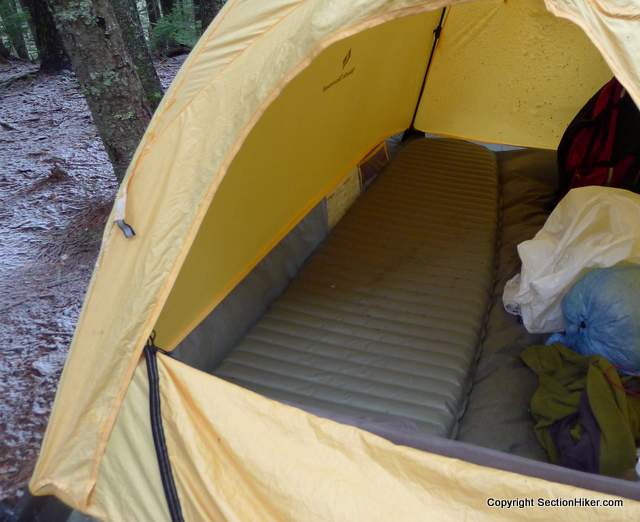
Camping and backpacking sleeping pads have R-values that measure how a lot insulation they supply in opposition to the chilly floor. Sleeping pads designed for chilly climate use have excessive R-values whereas ones designed for hotter climate have low ones. This is illustrated on this desk which reveals the R-values really helpful for various nighttime air temperatures.
| Air Temperature (F): | 50 | 30 | 25 | 10 | 0 | -15 | -25 | -40 |
| Minimum R-Value | 1 | 2 | 3 | 4 | 5 | 6 | 7 | 8 |
| Air Temperature (C): | 10 | -1 | -4 | -12 | -18 | -26 | -32 | -40 |
| Minimum R-Value | 1 | 2 | 3 | 4 | 5 | 6 | 7 | 8 |
If you solely camp in temperatures above freezing, a sleeping pad with an R-value of two or 3 might be enough. But what occurs if you happen to purchase a sleeping pad with a better R-value for winter tenting, like a Thermarest NeoAir XTherm which has an R-value of 6.9. Could you employ it in hotter temperatures and with out overheating and sweating all evening?
To reply this query (initially posed by a reader), I reached out to my technical contacts at Thermarest as a result of they’ve an elaborate in-house temperature testing facility for sleeping pads and sleeping luggage. I knew they’d present me with a solution based mostly on information, not conjecture as a result of they’re all engineering nerds. Got to like outside nerds.
I requested Brandon Bowers, who’s the class supervisor for sleeping pads, whether or not you might use an XTherm for tenting in scorching climate. He advised me “Using a high r-value pad in summer is a strategy some people use so they can eliminate the need for multiple sleep pads. I would not recommend this if nighttime temps are above 75 degrees, but this is a personal preference.”
While there are sure to be particular person variations with that threshold, it gives an excellent baseline to assist reduce the sum of money you spend on sleeping pads if you happen to plan to camp in summer season and winter. Take me, for instance: I keep away from winter tenting in temperatures under zero as a result of it’s simply no enjoyable freezing your ass off exterior under that when melting snow for consuming water, which may take some time. Zero levels, no drawback. But I’m over tenting in actually excessive chilly.
If you’re like me and nil levels is the coldest winter climate you wish to gear up for, somewhat than shopping for a NeoAir XTherm (R=6.9), you’d be higher off shopping for a Thermarest NeoAir XLite (R=4.2) for three-season use and stacking it with an affordable Thermarest Zlite Sol foam pad (R=2), for winter use (4.2+2=R6.2), since R-values are additive. You may even use an inflatable sleeping pad with an R=3 ranking and a foam pad. You all the time wish to carry a foam pad in winter anyway, so you will have insulation to sit down on when you’re cooking and melting snow or for an emergency.
In scorching summer season climate, you’ll in all probability be nice with the XLite as much as nighttime temps of 85 levels (F) or so. If you do mix the XLite and ZLite for winter, you wouldn’t have to purchase an XTherm in any respect as a result of it’s actually solely good for very chilly climate use and never for summer season temperatures.
I assume that’s sort of a nerdy evaluation. I’ll in all probability be promoting my XTherm quickly.
SectionHiker is reader-supported. We independently analysis, check, and fee the perfect merchandise. We solely generate income if you are going to buy a product by way of our affiliate hyperlinks. Help us proceed to check and write unsponsored and impartial gear opinions, newbie FAQs, and free mountain climbing guides.



